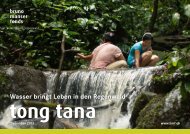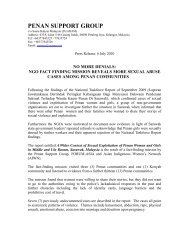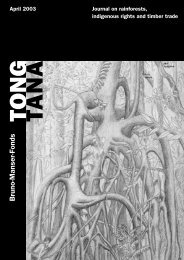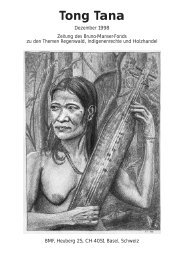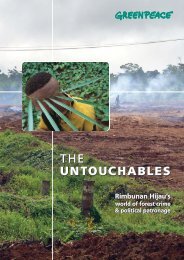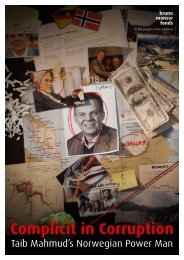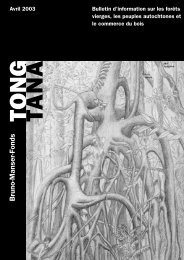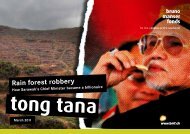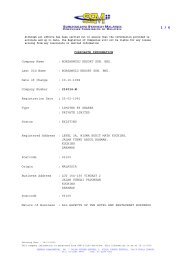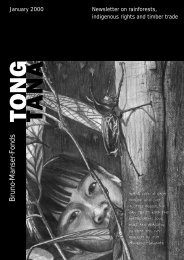Tong Tana - Bruno Manser Fonds
Tong Tana - Bruno Manser Fonds
Tong Tana - Bruno Manser Fonds
Create successful ePaper yourself
Turn your PDF publications into a flip-book with our unique Google optimized e-Paper software.
Speaking of wood: Amazon<br />
Ban on timber felling in Brazil<br />
a farce<br />
rg – Brazil’s Minister of the Environment,<br />
Jos‚ Sarney Filho, has partly lifted the ban on<br />
timber felling in Amazon due to pressure from<br />
the logging industry. Clear cutting continues<br />
unhindered. According to the secret service,<br />
eighty per cent of Brazil’s timber exports are<br />
from illegal sources. The remaining 20% are<br />
cut by the 377 registered logging companies<br />
which possess logging concessions for over<br />
16 000 square kilometers. Not all by far adhere<br />
to the guidelines for reforestation and<br />
careful logging techniques, as the “Neue<br />
Zürcher Zeitung” dated April 9, 1999, writes.<br />
The Malaysian timber companies WTK and<br />
Samling and the Chinese enterprise Tianjin reportedly<br />
have already bought several million<br />
hectares of forest for future logging. According<br />
to the “NZZ” all experts agree that the environmental<br />
controls have become more strict<br />
in Brazil. Whether this is sufficient to put a<br />
stop to the “timber sharks’” handiwork remains<br />
to be seen.<br />
The Amazon forest is disappearing<br />
faster than assumed<br />
rg – As reported by “Nature” in April<br />
1999, the rainforest is disappearing faster<br />
than assumed. A study questioned 1, 600<br />
people, especially owners of sawmills and<br />
Lowland tapir<br />
land owners. Additionally, aerial photographs<br />
were taken from aircraft. The researchers<br />
stated that their results were by far<br />
more reliable than the satellite photos used until<br />
now. According to the newest calculations<br />
about 44 000 square kilometers (the area of<br />
Switzerland) of rainforest were destroyed<br />
during the past year. This is almost three times<br />
the official Brazilian estimate.<br />
A split up rainforest becomes<br />
species-poor<br />
rg – Behind the front of the loggers and<br />
slash-and-burn farmers remains a rag rug<br />
landscape of patches of more or less intact<br />
forest with clear-cut and burned areas between<br />
them. Many of these small and isolated<br />
fragments are subsequently bought by environmental<br />
organisations or by the state and<br />
placed under protection. Very small areas,<br />
however, are not able to maintain the original<br />
biological/ species diversity, as the journal<br />
“Biological Conservation” (No. 89/1999)<br />
reports. Scientists investigated the number of<br />
mammals living within two large (each about<br />
20 000 hectares), two medium-sized (about<br />
2000 hectares each) and two small (about<br />
200 hectares each) rainforest fragments on<br />
the Atlantic coast of Brazil. Whereas all 36<br />
expected species of mammals were found in<br />
the large areas, 30–31 species remained in<br />
the medium-sized areas<br />
and only 22–23<br />
species were left in<br />
the smallest areas. Especially<br />
large species<br />
with low population<br />
densities roaming<br />
through large territories<br />
such as jaguars,<br />
pumas and lowland<br />
tapirs were missing in<br />
the small forested<br />
areas. Boundary effects<br />
are also especially<br />
detrimental for<br />
the small areas where<br />
a change in the temperature<br />
and wind<br />
regimes causes the<br />
microclimate inside<br />
the forest fragment to<br />
change and to foster<br />
forest fires.<br />
9



